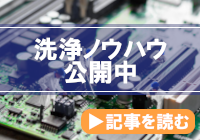news list
1~7 item / All 7 items
-

A page explaining the future of evolving printed circuit boards (PCBs) and the increasing importance of cleaning technology has been added.
The "Printed Circuit Board (PCB)" can be considered the heart of electronic devices; it serves as a foundation for mounting electronic components and electrically connecting them. The fine wiring patterns formed on this board become pathways for electronic signals, and the electronic components are fixed and connected by solder. From smartphones to automobiles, home appliances, and medical devices, PCBs have become an indispensable part of various technologies in modern society. In this article, we will introduce the main types of printed circuit boards (PCBs), the future prospects seen from the development of these boards, and the cleaning technologies that are required. Please see the related links for more information.
-

A page titled "What is an SDS (Safety Data Sheet)?" has been added.
An SDS (Safety Data Sheet) is a document that contains important information regarding the handling of chemical substances, relevant regulations, disposal and transportation methods, as well as hazards and toxicity. The applicable regulations for flux cleaning agents, the presence or absence of flash points, usage precautions, the necessity of protective equipment, and disposal methods are detailed over more than 10 pages. In this article, we will explain important points that we particularly want you to pay attention to, as well as frequently asked questions, in a column format. Please see the related links for more information.
-

We have added a page titled 'What is PCB Cleaning? An explanation from basic knowledge to the latest trends in cleaning challenges.'
What is substrate cleaning? Is substrate cleaning unnecessary? We provide a detailed explanation of areas where flux cleaning is necessary, among other topics. In Japan, many cases adopt no-clean paste, but cleaning has become essential to ensure high reliability. We also address the latest cleaning challenges, such as the impact of ionic residues and metal salts on insulation resistance, in this column. Recommended for those who: * Want to investigate the causes of defects despite cleaning * Want to know the latest cleaning challenges and evaluation criteria * Want to explain and promote substrate cleaning within their company, etc. Please see the related links for more information.
-

A page titled "Cleaning Technology Required for Sintered Joint Devices" has been added.
This document explains the cleaning techniques required for sintered joining devices. It discusses the background for the need for cleaning in sintered joining devices and the differences from flux cleaning, as well as introducing specific cleaning processes. It also includes information on the selection of cleaning agents and methods, as well as cleanliness analysis after cleaning. We encourage you to read it.
-

Added a page on "Evaluation of cleanliness after cleaning: Analysis methods for flux residues and residues after sintering bonding."
In recent years, the miniaturization and densification of electronic devices have progressed, and along with this, the evolution of the bonding materials used has also overlapped, making contamination more complex. Particularly in fields such as automotive, aerospace, space, and high-capacity communications, there is an increasing number of cases requiring high reliability, and concurrently, there is a demand for thorough cleaning from the perspective of quality assurance. Inadequate cleaning can lead to issues such as poor wire bonding, inadequate adhesion of resin in molding, and the occurrence of migration, which is a well-known fact. However, in recent years, there have been many cases where defects occur in later processes despite passing inspections, and we have seen an increase in inquiries to our company regarding this issue. Why do such cases arise? This time, we will explain the importance of cleanliness evaluation after cleaning.
-

A new page on "Technological Evolution in Electronics Implementation" has been added.
Electronics assembly refers to the technology of attaching electronic components to a substrate. Specifically, it is the process of joining components such as semiconductors, resistors, and capacitors to a printed circuit board to form an electrical circuit. The sizes of these components tend to become smaller in response to the demands for higher performance and space-saving in products, and accordingly, fine joining technology is also evolving. This has a significant impact on the cleaning process as well. This document explains the evolution of joining technology and cleaning in fine joining.
-

Compliance with Regulations and Safety Measures for Cleaning Agents: A Step-by-Step Explanation of Purchase, Use, and Storage
We have added an article that explains "Compliance with Regulations and Safety Measures for Cleaning Agents" step by step regarding purchasing, using, and storing them. In recent years, from the perspective of environmental conservation and human protection, countries have strengthened regulations concerning the handling of chemical substances, and there is a global trend towards initiatives related to the SDGs (Sustainable Development Goals). In Japan, the Industrial Safety and Health Act will be revised in April 2024, strengthening the handling of chemical substances. To reduce health risks for workers and environmental impacts, some companies are moving to avoid procuring materials that have a significant environmental burden, and cleaning agents are no exception. Taking into account efforts abroad, we will introduce the regulations related to cleaning agents.
